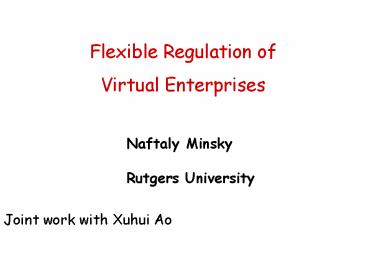Flexible Regulation of Virtual Enterprises - PowerPoint PPT Presentation
Title:
Flexible Regulation of Virtual Enterprises
Description:
Flexible Regulation of Virtual Enterprises Naftaly Minsky Rutgers University Joint work with Xuhui Ao Outline The challenges to access control posed by e-commerce. – PowerPoint PPT presentation
Number of Views:27
Avg rating:3.0/5.0
Title: Flexible Regulation of Virtual Enterprises
1
Flexible Regulation of Virtual Enterprises
Naftaly Minsky Rutgers University
Joint work with Xuhui Ao
2
Outline
- The challenges to access control posed by
e-commerce. - Regulation of virtual enterprises a case study.
- The law-governed interaction (LGI) mechanism, and
how it meets the challenges to access control. - Conclusion
3
The Challenges to AC
- The distributed and open nature of E-commerce,
and its scale. - PKI facilitates scalability
- but enforcement of AC policies is still done
largely in a centralized fashion, making it hard
to scale. - The need for more sophisticated policies, e.g.,
- Stateful policies, sensitive to the history of
interaction, like budgetary control. - Policies that mandate extra actions, like state
change, or auditing.
4
The Challenges to AC (cont)
- The need for communal (rather than
server-centric) policies, such as - An enterprise-wide policy governing a set of
servers. - Decentralized electronic marketplace.
- B2B commerce, and supply chains.
- The need for interoperation between different
policies, and for hierarchical organization of
policies. - All these challenges need to be met via a single
scalable mechanismfor specifying policies, and
for enforcing them.
5
Governance of Virtual Enterprise(a Case Study)
- Consider a coalition C of enterprises E1,...,
En, governed by a coalition-policy PC---where
each Ei is governed by its own internal-policy
Pi . - As in virtual enterprises, supply chains, grid
computing, etc.
6
Policies Governing a Virtual Enterprise(an
Example)
Roles each Ei should have its director Di()
and the coalition C a director DC.
A director Di can mint Ei-currency i needed to
pay for services provided by Ei and it can give
DC some of this currency
A director DC can distribute some of its i
currency among other directors.
i Currency cannot be forgedby anyone!
Servers at E1 can send their earning in 1 back
to their director
A director D2 can distribute its i budget among
agents at its enterprise
7
The Main Challenges
- The flexible formulation of such policies, so
that - they will be consistent, and
- their specification and evolution would be
manageable. - Enforcement of such policies, and in a scalable
manner.
8
The Compositions Approach
- Given the set PC , P1,. . ., Pn of policies.
- Construct a set composed policies Pi,j
composition (Pi , PC , Pj) - Provide these compositions to the reference
monitor (RM) that mediates all
coalition-relevant interactions. - Compositions were studied by Gong Qian 96,
and by Bidan Issarny 98, ...
9
and its Problematics
- It is unlikely for arbitrary, and independently
formulated, policies to be consistentso such
composition is likely to fail. - Policy composition is computationally
intractable(McDaniel Prakash 2002)and, we
need N2 such compositions! - Inflexibility consider changing a single Pi . .
.
10
The Proposed Approach
- Instead of creating N2 compositions (Pi , PC ,
Pj), we will enable each enterprise Ei to create
it own policy Pi , subject only to the constraint
that Pi would conform to PC . - We will then allow Ei and Ej to interoperate,
each enforcing its own policy, Pi Pj
respectively - We will do this via the control mechanism called
law-governed interaction (LGI).
11
Law-Governed Interaction (LGI)(main
characteristics)
- LGI is an access-control and coordination
mechanism - LGI is communal can impose mandatory policies
(called laws) over an entire community. - Enforcement is decentralized for scalability
(actually, supports a whole spectrum of
decentralization). - Supports a wide range of laws including those
that mandate extra actions, in a stateful
manner. - Supports hierarchy and interoperability.
- Efficient (overhead of about 0.1 ms), and
incremental. - Due to be released this summer.
12
Centralized Enforcement of Communal Policies
The problems potential congestion, and single
point of failure
Replication does not help, if S changes
rapidly enough
13
Distributed Law-Enforcement under LGI
14
Deployment of LGIvia a Distributed TCB (DTCB)
15
On the basis for trust between members of a
community
- For a pair of interlocutors to trust each other
to comply with the same law, one needs to ensure
- that the exchange of messages is mediated by
correctly implemented controllers . - that interacting controllers operate under the
same law L. - Such assurances are provided, basically, via
certification of controllers, and the exchange of
the hash of the law.
16
Hierarchy Organization of Coalition
Policies(back to the case study)
PC
superior
subordinate
P1
P2
Pn
Pi is defined as subordinate to Pc, as thus
constrained to conform to it.
17
Interoperability
- Let us focus on the interoperability between E2
and E1
18
Interoperability (cont.)
19
Conclusion
- LGI implementation via the Moses middleware is to
be released in May 2005, viahttp//www.cs.rutger
s.edu/moses/ - This initial release would not support policy
hierarchy. - For a complete treatment of the coalition
problem, see Flexible Regulation of Distributed
Coalitions Ao and Minsky In Proc. of the 8th
European Symposium on Research in Computer
Security (ESORICS) October 2003.
20
Questions?
21
Server-Centric Access-Control (AC)
server
Reference Monitor(RM)
It generally supports only stateless, purely
reactive, ACL-based policies, enhanced with
RBACand this is far from sufficient.
22
Enforcing a Communal AC Policy
The communal policy may be that certain type of
transactions need to be monitores
Enterprise-wide (communal) policy P
Enterprise































